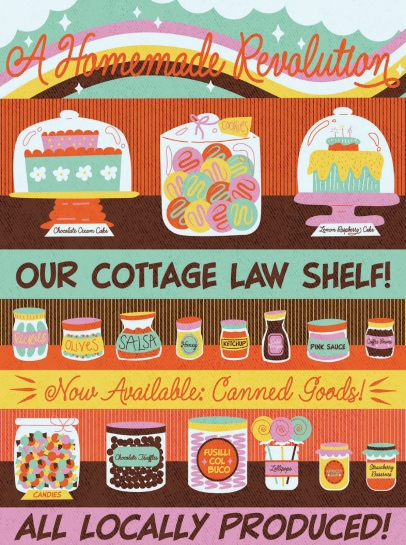Recipe for Success
Oklahoma’s food community spearheaded amendments to the State’s cottage food laws. How has the implementation affected small, local producers and markets?
Jonnie Holmes, owner of Jake’s Jams in Tulsa, was told she couldn’t sell her jams and jellies without having several of her products tested at Oklahoma State University. At $225 per jam, the cost of tests was daunting. And that wasn’t all.
Prior to a 2021 change in state law, Holmes and most other food entrepreneurs were required to produce all of their products in a commercial kitchen. Commercial kitchens have safety standards for their equipment and design, and they are inspected and licensed by the Health Department — another annual expense. Building a commercial kitchen from scratch can cost tens of thousands of dollars; renting space in a shared kitchen is possible, but there’s a shortage of available, affordable kitchens in most communities, including Oklahoma.
With so many barriers between her and a profitable business, Holmes, who had been producing jams from her home, decided to stop production for eight months. Luckily, that wasn’t the last chapter for Jake’s Jams — policy advocates and legislators came to her aid.
Cottage food law is a term used across the country to describe legislation regulating how, where, and what homemade food can be sold. Until the Home Bakery Act passed in 2017, Oklahoma had very conservative cottage food laws, with virtually no legal path for home-based businesses to sell to the public. The Home Bakery Act made it legal for baked goods — and only baked goods — to be sold at farmers’ markets, co-ops, and other limited venues, but not retail stores. But the Homemade Food Freedom Act that went into effect in 2021 greatly expanded the list of allowable foods, and a wide range of homemade food can now be sold in retail stores as well.
Holmes says the new regulations have been encouraging, opening up more opportunities for business owners and consumers. “I’m not stuck in a box anymore,” she says. “I can experiment with new flavors without getting each one tested, and I can expand my small business without going into debt.”
And small business is a key aspect of the legislation — to be covered under the law, producers can’t sell more than $75,000 in a year. The idea is to make it easier for businesses to get started and grow.
To be covered under the new regulations, foods have to be shelf-stable and may not contain any cannabis, meat, poultry, seafood, or unpasteurized milk. That leaves a lot of options on the table, including jams, jellies, pickles, ferments, sauces, juices, spice blends, and baked goods of all kinds.
Angela Renee Chase, the co-owner and operator of Flora Bodega, a local cooperative grocery store in Oklahoma City, is one of the people who helped knock on the doors of legislators at the State Capitol to advocate for changes to the law. “Oklahoma refers to itself as a ‘farm state,’ but a lot of those basic foods that people were buying or trading [were] illegal,” she says.
Food retailers like Chase also benefit from an expanded selection of products to carry. Carrie Beth Winfield, one of the owners and market managers of Farm Hippie Farmers Market in Collinsville, said she has seen the number of food vendors nearly double since the law changed. “The fact that we strayed so far from our roots as Oklahoma, small-scale producers is astounding, but now the sky’s the limit on the way we can all move forward,” she says.
Mary Bixler was the Scissortail Park Farmers Market manager during the 2022 season after the new rules were implemented, so she saw firsthand how the change impacted businesses.
“I saw a significant increase in the types of vendors we were able to serve with our market,” Bixler says. “I think that was really the point of the bill, to make economic enterprise more accessible. We had quite a few people come in doing ferments. Jams and jellies opened up a lot. We had two fresh juice vendors, a new spice vendor, and an iced tea vendor.”
For consumers, the rule change brings more selection, but also new food safety considerations. Bixler is now a public information officer with the Cleveland County Health Department, one of the agencies tasked with enforcing the new rules.
“The results of overhauling that bill were overwhelmingly positive, but it also blurred the lines for people around what is and is not cottage food,” she says. “It created more room for error. Not everyone who deals with food knows the science around foodborne illness. The public doesn’t always understand the risks involved in the food they eat.” All food made at home should carry a label clearly stating that the product was produced outside of a commercial facility, but it is almost impossible to inspect thousands of products at venues across the state.
The new laws apply statewide, but, as with most legislation, the devil is in the details left to local agencies to write and enforce. That means rules and enforcement vary by county, which is confusing for businesses and consumers alike. For example, producers in some counties are required to have specific food safety training before selling to the public, while in other locations, they aren’t.
Despite the confusion, Bixler is optimistic. “Business owners are making good choices about the cleanliness of their products,” she says. “They want people to buy their products and like them. We never had any concerns with our vendors at the Scissortail market.”
Katherine Whalen is one of many producers with safety on her mind. She serves as managing director of gardens and outreach at St. Francis of the Woods, a non-profit retreat center near Coyle.
“Food safety is super important — probably the most important thing,” Whalen says. “It’s in my best interest to make sure my food is safe. From a personal standpoint, I put a lot of intention into what I do, especially when I’m canning.”
St. Francis of the Woods is also a perfect example of another goal of the legislation coming to fruition: Advocates hoped that more lenient cottage food laws would allow farmers to preserve their excess harvest, preventing food waste and adding another revenue stream.
“The pear trees are a great example,” Whalen says. “They produce all at once, and we don’t have many markets to sell the pears. This was the first year I could sell pear butter. Otherwise, some of the pears would end up in the compost. It was helpful for our budget.”
Now the pear butter is canned and sold on-farm and at stores like Flora Bodega.
For the smallest producers, like St. Francis of the Woods, selling homemade food might be the perfect solution moving forward. For others, like Jake’s Jams, it is a stepping stone, which was another goal of the legislation.
Holmes’ ultimate dream is to move into a commercial kitchen to produce Jake’s Jams. In the meantime, she can continue to grow at her own pace. “Maybe one day I’ll go after Smucker’s, but not today,” she says. “I enjoy being a small business in the local food community. The new law enables me to do that.”





